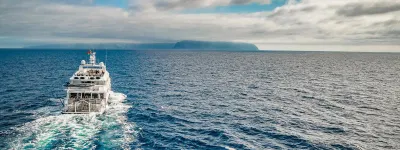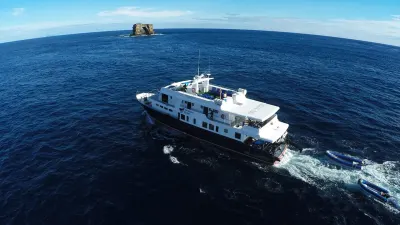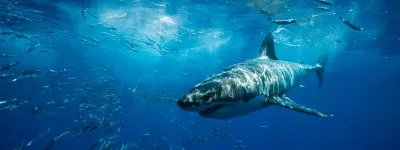Thought to be the real-life inspiration behind Treasure Island and Jurassic Park, isolated Cocos Island is one of the world’s last true diving frontiers. Located over 500-kilometres from Costa Rica’s western coast, there are few other dive destinations this remote – and even fewer offering such mind-blowing biodiversity and underwater experiences.
In this article, we’ll explore the very best dive sites of Cocos Island, each chosen by our team of expert dive travel advisors. So keep reading and start planning the trip of a lifetime today!
An introduction to Cocos
- National park and UNESCO World Heritage site
- Over 500-kilometres from the mainland, requiring a 36-hour crossing
- Located at a crossroads for several significant currents
- Home to tiger sharks, silkies, Galapagos sharks, and hammerheads
- Manta rays, dolphins, whale sharks, and even humpbacks

Cocos Island – or Isla del Coco – is both a national park and designated UNESCO World Heritage site, playing host to a remarkable degree of endemism and providing a snapshot of what tropical ocean habitats once looked like. On land, Cocos is covered in dense rainforest which turns to cloud forest as it clambers skywards up the island’s volcanic peaks. These untouched habitats are both magnificent and mysterious, although they are home to endemic bird and reptile species rather than the dinosaurs of Jurassic Park fame.
The only part of a vast underwater ridge to break the surface, the volcanic island of Cocos lies at the crossroads for several significant currents. These currents have helped create a melting-pot of marine life from elsewhere in the Pacific and have earned this island the nickname “little Galapagos”. Divers visiting Cocos can expect to encounter tiger sharks, silkies, Galapagos sharks, and hammerheads schooling by the hundreds, not to mention manta rays, dolphins, whale sharks, and even humpbacks.
Of course, these oceanic currents also mean Cocos is best-suited to experienced divers, and the epic 36-hour crossing isn't for those with little experience of being at sea. But, while it may take a while to get to, once you arrive at Cocos you won’t have to travel large distances between dive sites, guaranteeing plenty of time to explore all the local highlights.
Cocos island's top dive sites
There are just over 20 dive sites around the small island of Cocos, a unique playground for adventurous scuba divers – and you’ll likely get the chance to explore them all.

Bajo Alcyone
- One of the best dive sites in Cocos, if not the world
- Dolphins, turtles, sailfish, bigeye trevally and yellowfin tuna
- Schools of 500 or more individual hammerhead sharks
- Chance of whale sharks, mantas, silkies, and Galapagos sharks
First discovered by the Cousteau Society’s expedition ship, Alcyone, this seamount now has a reputation as one of the best dive sites in Cocos, if not the world. Lying more than a kilometre offshore, Bajo Alcyone offers incredible action no matter when you visit. Divers will descend quickly to a depth of around 25-metres, where they are met by pelagics of all varieties, including whitetip and blacktip reef sharks, dolphins, turtles, sailfish, and colossal schools of bigeye trevally and yellowfin tuna.
During the rainy season which runs from June through November, the real stars of the show appear. During this time, schools with 500 or more individual hammerhead sharks have been documented, creating a ‘wall’ that extends as far as the eye can see. Whale sharks, manta rays, silkies, and Galapagos sharks can also be encountered. Of course, the reef also provides plenty to see, with octopuses, eels, and the endemic Cocos blenny hiding out amongst the coral.
Dirty Rock
- Named after the guano-painted rocks breaking the surface
- Volcanic boulders and pinnacles rising up from the depths
- Cleaning station for manta rays and various shark species
- Vast schools of hammerheads are sometimes seen
Named after the jagged guano-painted rocks protruding from the surface, Dirty Rock is another of Cocos’ more famous dive sites, and for good reason. This craggy, rugged reef is made of volcanic boulders and pinnacles rising up from the depths, along with cleaning stations that line Dirty Rock's calm channel. Here, divers can find manta rays and sharks of all shapes and sizes getting picked clean of parasites, as well as a small cave full of lobsters, and the odd octopus probing the reef.
Out in the blue, vast schools of hammerheads are sometimes seen, along with towering schools of jacks and leather bass, and even the occasional pod of dolphins! To maximise your chances of seeing hammerheads, head east towards a viewing area at around 30-metres, remaining as still and calm as you can while you wait for the sharks to come to you.
Dos Amigos
- Twin dive sites often dived one after the other
- Hammerheads, tiger sharks, reef sharks, and marble rays
- Supersized schools of snapper and rainbow runners
- Can be inaccessible during rainy season due to surge
These “two friends” are actually twin dive sites, often explored one after the other depending on the currents. Located on the exposed southern side of Cocos Island, these islands are not always accessible during the rainy season due to the rough surge. But, when conditions are right, these sites offer an unparalleled underwater spectacle.
Big Dos Amigos, the larger of these two rocks, is famous for an underwater archway which rises some 15-metres from the sandy bottom below. This magnificent archway provides an unforgettable backdrop for close encounters with sharks, including hammerheads and tigers, as well as marble rays, and supersized schools of snapper and rainbow runners. The smaller rock features a jagged bottom and strong surge graced by more hammerheads, reef sharks, and the occasional oceanic blacktip.

Manuelita Island
- Typically the first stop for liveaboard itineraries to Cocos
- Small enough to explore on a single dive, but often split into two
- Tiger sharks, hammerheads, eagle rays and mantas
- Home to one of the only true coral gardens in Cocos
Situated off the north coast of Cocos, Manualita Island is often the first stop for liveaboards in Cocos. Manuelita is also the largest of Cocos’ satellite islands, yet it is still small enough to be circumnavigated on a single dive. Despite this, it is often split into two separate dive sites, due to the starkly different environments on offer.
At Manuelita Deep – also known as Manuelita Outside – divers will quickly descend along a sloping boulder field to discover cleaning stations frequented by tiger sharks and hammerheads, as well as eagle rays and mantas. The site’s northern section transforms to a plummeting wall where plenty of bigger marine life in all shapes and sizes might cruise by. Manuelita Garden – also known as Manuelita Inside – is located on the island’s east side is shallower, calmer, and boasts one of the only true coral gardens in Cocos.
Punta Maria
- Tip of an underwater mountain, located 500-metres from the island
- Cleaning station frequently visited by Galapagos sharks
- Chance of mantas, silkies, and schooling hammerheads
Punta Maria is the tip of an underwater mountain, located 500-metres off the island's southwestern coast. This seamount rises from the deep sandy seafloor to a depth of around 25-metres, alongside two pinnacles that can only be visited when the current permits. A cleaning station at this site is frequently visited by Galapagos sharks, making Punta Maria one of Cocos’ best sites for spotting this spectacular species.
Punta Maria’s famously strong currents also attract a range of other powerful pelagic species, and divers should keep an eye on the drop-off for passing mantas and silkies, and sometimes even schooling hammerheads. But be careful, heading out to the blue can be dangerous at this open and exposed site – stick close to the wall and keep an eye on your depth!
Everest
- Underwater pinnacle at a depth of 90-metres
- Explored with the DeepSee Submersible
- Spot endemic red-lipped Cocos batfish
- Skipjack tuna, mobula rays, and hammerheads
While it isn’t technically a dive, taking a trip to this submerged site aboard the DeepSee Submersible is a once in a lifetime opportunity to explore Cocos’ depths. The DeepSee Submersible is a custom-built one-atmosphere submarine, capable of carrying a pilot and two passengers to a depth of 450 metres. You’ll head down to around 90-metres, scouring the depths for weird and wonderful wildlife such as the endemic red-lipped Cocos batfish hopping amongst the octocorals, black coral bushes, and basket stars.
Everest itself is a pinnacle that is some 50-metres tall and is peppered with deep-water coral patches. On the trip back up, you’ll slowly ascend the volcanic mountain searching for wildlife not seen in the shallows while the silhouettes of skipjack tuna, mobula rays, and scores of hammerheads circle the steep slopes above.

The Wall
- Underwater trench with a maximum depth of 300-metres
- Explored with the DeepSee Submersible
- Spot animals such as jellynose fish and prickly sharks
- Ledges, overhangs, steep sandy slopes, and vertical walls
This is another DeepSee Submersible experience located due east of Manuelita Island. And, beginning at 200-metres below the surface, it’s safe to say this site is well below the reach of recreational diving. The submersible will explore the many ledges, overhangs, steep sandy slopes, and vertical wall sections of the trench, reaching an impressive maximum depth of 300-metres.
Exploring this deepwater trench is like stepping into another world – where creatures live in darkness and the sub's powerful lighting guides the way. Many of the animals seen, such as jellynose fish and prickly sharks, are almost exclusively found in deep water environments, so you’re very unlikely to ever see them on recreational dives.
Ready to start planning your adventure to Cocos Island?
Search, compare and book from our hand selected liveaboards
Need some inspiration?
Tell us what you’d like to see and when you’d like to travel, and our destination finder will reveal your ideal dive destination.
Need some inspiration?
Tell us what you’d like to see and when you’d like to travel, and our destination finder will reveal your ideal dive destination.






